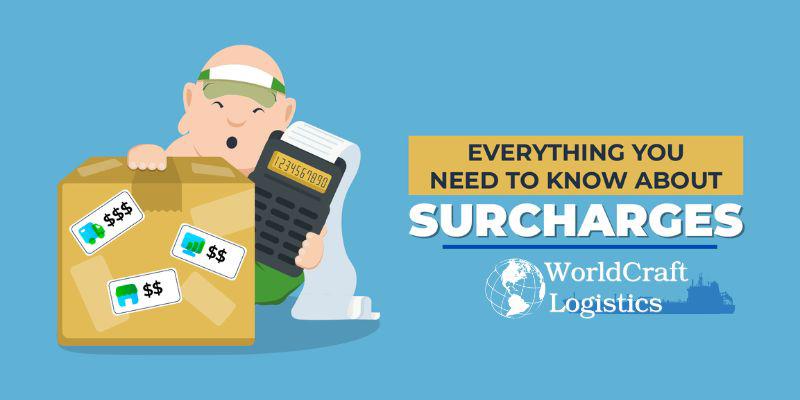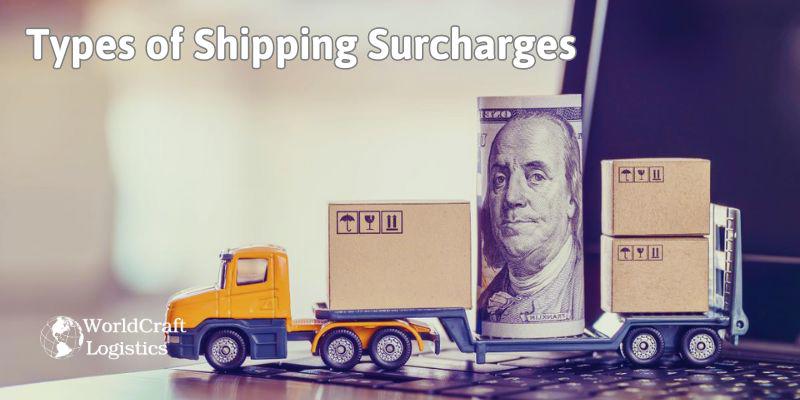
Starting June 1st, 2023 Our warehouse fee will be $0.65/cubic foot per month
In effort to lower the warehouse storage fee during inflation, we have went narrow aisle racking.This construction took us four months but the project is finally completed. With narrow aisle racking, we are able to drop storage by 24%.We as partners will go through this inflation together.
03/10/2024
In the world of eCommerce, shipping is a must-do, but hey, sometimes those packages come with extra costs—cue the shipping surcharges. These are like surprise fees thrown in by shipping couriers for the extra mile they go to get your packages delivered.
Now, with eCommerce booming, it's crucial for businesses to crack the code on these additional shipping fees. A recent study spilled the beans, revealing that these fees play a big role in snagging and keeping customers, not to mention influencing how much they buy. So, businesses need to dive deep into understanding these surcharges and master some savvy tips to dodge them. It's the secret sauce to keeping those profit margins intact!

Shipping surcharges are those extra charges carriers slap onto your shipping bill. They're like little add-ons to cover the carrier's extra costs for special handling, out-of-the-ordinary delivery situations, or other unique shipping circumstances. Let's break down some common types of shipping surcharges you might encounter:
Delivery Area Surcharge: When carriers like UPS or FedEx have to trek way beyond their usual delivery zones.
Additional Handling Surcharge: This one kicks in for packages longer than 48″.
Signature Requirement Surcharge: Depending on whether they need the recipient's signature, an adult's signature (21 years or older), or any signature at all.
Residential Surcharge: Applied for deliveries to homes or home-based businesses.
Declared Value Surcharge: Protecting parcels with contents valued at least $100.
Print Return Label Surcharge: When you use a provided return label for shipping.
OS Extra Surcharge: A miscellaneous catch-all for extra fees in international shipping, freight, or other exceptional situations.
To stay ahead of the game, get a comprehensive list of surcharges from all your carriers, and keep tabs on what you're paying. Some savvy sellers might tack on extra handling fees for orders that could trigger a shipping surcharge. Just be mindful of how much your customers are willing to fork out for their orders.
Check out some related articles to help you improve your knowledge about the transportation industry:
👉 The Master Bill of Lading and the House Bill of Lading
👉 How to Calculate Cubic Feet ACCURATELY for beginners
👉 Packaging in shipping: Definition, effective solutions for cargo

Shipping surcharges come in a variety of forms, and they play a significant role in influencing overall shipping expenses. For merchants keen on optimizing costs, decoding these surcharges is crucial. It's not uncommon for the multitude of surcharges to leave merchants scratching their heads as they calculate their shipping expenses.
To gain clarity and control over your shipping budget, it's essential to understand the specific types of surcharges that regularly appear on your invoices. This breakdown will empower merchants to make informed choices, identify potential cost-saving opportunities, and ensure speedy deliveries without incurring unnecessary expenses.

Private carriers continuously assess fuel surcharges, aligning them with the volatile fuel market. These surcharges hold immense significance for carriers in ensuring sustained profitability, particularly in the context of enduring contracts with shippers. Neglecting to factor in escalating fuel expenses can lead private carriers to incur losses with each delivered shipment.
Monitoring fluctuations in fuel charges is imperative as it can result in a significant surge in shipping expenses for businesses. Our recent investigation revealed that fuel surcharges, affecting over 2.5 million shipments, imposed an additional cost of $2.2 million, equating to approximately $0.88 extra per package.
Each private carrier individually calculates fuel surcharges, introducing variability across carriers. Delving into the intricacies of these calculations sheds light on the pivotal role fuel surcharges play in determining ongoing costs.
To illustrate, let's delve into the methodologies employed by two major private carriers in the United States, UPS and FedEx, for calculating their fuel surcharges. UPS implements its fuel surcharges every Monday, based on the fuel charge index from the preceding two weeks. In contrast, FedEx computes its ground service fuel surcharges differently, relying solely on the average diesel cost from the previous week.
Fuel Surcharges: Tips for Shippers

If you're a shipper catering to direct residential deliveries, it's crucial to grasp the implications of residential delivery surcharges on your shipping expenses. These surcharges, as the name suggests, are additional fees imposed by carriers for deliveries made to residential dwellings.
The ambiguity surrounding residential delivery surcharges becomes evident when determining the precise definition of a residential dwelling. Typically, this fee hinges on the delivery address, and it's at the carrier's discretion to classify an address as either residential or commercial.
Discrepancies arise in how different private carriers make this determination. For instance, UPS and FedEx apply residential delivery fees when shipping to addresses classified as residences, regardless of business operations. UPS utilizes a unified ground network, whereas FedEx offers a specialized Home Delivery service, potentially resulting in lower residential surcharges.
Residential Surcharges: Tips for Shippers
In the quest to slash residential surcharges, shippers are advised to navigate the diverse array of shipping options and networks at their disposal. FedEx's Home Delivery stands out as a network offering a diminished surcharge for residential drop-offs. Shippers can also explore alternatives such as FedEx Smart Post or UPS SurePost. These networks take charge of the package throughout most of its transit, later entrusting it to USPS for the final leg of the journey, effectively nullifying the residential delivery fee for shippers.
Cleverly tapping into alternative shipping networks empowers shippers to sidestep the escalating costs associated with residential deliveries. As these fees continue to climb, this strategy remains a vital and continually evolving avenue for shippers to curtail expenses.

Private carriers are slapping an oversize package surcharge on deliveries that surpass specified weight or size limits. This additional fee could lead to a significant uptick in shipping expenses for shippers.
In a recent survey conducted by our team, we found that 594 instances of oversize shipping triggered an average cost surge of around $50.00 per shipment within a 12-month period. This underscores the imperative for shippers to exercise caution when facing potential oversize package surcharges and explore alternative shipping avenues.
Both UPS and FedEx wield the oversize package surcharge tool, imposing fees if a shipment breaches their established size or weight thresholds. The dimensional girth, capped at 130 inches, serves as a critical limit for both carriers.
Weight thresholds hinge on the shipper's chosen delivery network. Should a package fall below the 130-inch dimensional girth but exceed the carrier's weight threshold, it is flagged as oversized, inviting corresponding charges. Packages surpassing both weight and size limits may attract multiple surcharges from the carrier.
Therefore, if you want to save some money, contact 💡 Worldcraft Logistics' oversized shipping service. We will advise you on balancing techniques.
Oversize Package Surcharges: Tips for Shippers
In the dynamic realm of shipping logistics, shippers must remain vigilant about oversize package rates and the stipulated thresholds imposed by carriers. The fluid nature of these rates necessitates constant awareness to ensure shippers are not caught off guard by any sudden changes.
For shippers accustomed to dispatching oversized or sizable packages, there exists an opportunity to capitalize on substantial cost savings through strategic negotiation in response to rate fluctuations. Take, for instance, regular users of FedEx for oversize shipments, who may explore the possibility of renegotiating their contracts to eradicate handling fees associated with these packages, thereby unlocking noteworthy financial benefits.

Shipping on Saturdays proves to be a costly affair for shippers. According to our investigation, Saturday deliveries tack on an extra $13.49 per package to shipping expenses. It's not just the deliveries; opting for Saturday Pickup services results in an average uptick of $14.95 per package. For shippers relying heavily on Saturday Delivery and Pickup services, these additional charges become a pivotal factor driving up overall costs.
As the term suggests, Saturday surcharges are levied on deliveries outside the standard Monday to Friday workweek. With customers increasingly anticipating weekend deliveries, shippers find themselves compelled to explore alternative delivery options. A popular strategy to sidestep Saturday surcharges is to utilize USPS Priority Mail for shipping. Priority Mail offers a notable advantage by not imposing surcharges for Saturday deliveries, a welcome relief for shippers striving to meet customer expectations for weekend delivery services.

Courier services levy surcharges to offset expenses related to specific tasks beyond the fundamental process of transporting a package from origin to destination. In response to the escalating influx of eCommerce packages, carriers frequently employ surcharge mechanisms to regulate their delivery capacities. These charges constitute a continuous fluctuation, strategically anticipating demand to prevent parcel congestion. This dynamic nature elucidates the divergence in surcharge structures across different courier companies, evolving over time.
Notably, instances of peak season surcharges are prevalent, particularly during the Christmas period. Here are some common surcharges imposed by private couriers.
Navigating through the labyrinth of shipping surcharges may prove to be a costly expedition for your overall shipping expenses. The intricacies of calculating total shipment costs become even more perplexing when merchants grapple with the diverse surcharge structures employed by various couriers. As elucidated earlier, these discrepancies stem from a myriad of factors influencing the surcharge policies of different private couriers. Presented below is a comprehensive breakdown detailing how these commonplace couriers levy surcharges.

The United States Postal Service (USPS) provides a range of services, including Priority Mail Express, First-Class Mail, Media Mail, Retail Ground, and Priority Mail. Similar to other courier services, shipping costs are determined by the weight of the package and the number of zones it traverses. However, USPS may levy additional surcharges under specific conditions.
One such surcharge is the USPS non-machinable surcharge, applicable to First-Class envelopes and parcels that cannot be processed automatically. This category includes irregularly sized envelopes and items that are too rigid or contain components that may entangle with other mail. Customers incur charges for the utilization of specialized machines that assist in sorting and segregating their parcels.
Presently, non-machinable surcharges vary from $0.15 to $0.21. Additional insurance, if not part of the selected service, incurs an additional cost of $2.25 for basic add-ons, with rates exceeding $9.55 for higher coverage. Signature-on-delivery options range from $2.65 to $8.45. For a comprehensive list of surcharge rates, refer to the provided information.
In utilizing FedEx for your shipping needs, be aware of potential supplementary fees beyond the standard rate. Similar to its counterparts in the courier industry, FedEx imposes varied fees contingent upon the parcel's origin country and characteristics. Specialized shipments may attract extra costs, such as an additional handling surcharge. This surcharge is applicable to both express and ground packages exceeding 48 inches in length and 30 inches in width.
Moreover, distinct weight thresholds trigger supplementary charges, with packages exceeding 50lbs for U.S. ground services and 70lbs for international services incurring additional fees. These fees are notably substantial, amounting to an extra $230 per shipment for both domestic and international freight services.
It's crucial to note that various factors, including packaging methods, can influence the imposition of shipping surcharges. Address-related fees may also come into play, with FedEx charging $16 for address correction, $4.40 for residential deliveries, and a $4.20 surcharge for deliveries outside their regular operating area. Stay informed about these potential charges to ensure a transparent and cost-effective shipping experience with FedEx.
UPS imposes several shipping surcharges for their services. The fuel surcharge, for instance, is index-based and adjusted weekly. Like other shipping companies, the rates are based on the Gulf Coast price for fuel, as published by the EIA. UPS also charges delivery and remote area surcharges, and an international extended area surcharge. As an example, the company charges $16.40 for address correction, $5 for residential delivery, and a $3.80 outside delivery area surcharge.

Courier companies meticulously devise their rates, factoring in elements like business expansion forecasts and profit margins, with surcharges emerging as a consequence. Although some surcharges can be sidestepped, others, such as fuel or peak season surcharges, remain inevitable. Crafting adept negotiations with your courier service provider can potentially mitigate the impact of these unavoidable fees. Alternatively, discover below several approaches to evade or diminish the surcharges you encounter.
✍️ Sidestep address-related surcharges by meticulously verifying your address or utilizing shipping software equipped to automatically validate and rectify delivery addresses.
✍️ Initiate a conversation with your courier representative to secure a diminished additional handling rate.
✍️ If you frequently ship to specific rural areas, investigate regional courier alternatives to potentially reduce costs.
✍️ Stay informed about the courier's criteria for categorizing packages as "oversized."
✍️ When faced with residential delivery surcharges, evaluate the feasibility of redirecting items to a business address. Alternatively, factor these charges into your financial calculations and, if necessary, incorporate them into customer pricing.
✍️ Contemplate the current fuel market prices and engage in negotiations to secure a reduced fuel surcharge.

Minimizing your shipping costs demands a savvy approach to surcharges. It's crucial to grasp the intricacies of shipping surcharges to steer clear of unnecessary expenses. By gaining a comprehensive understanding, you can effortlessly distinguish between the diverse surcharge types and their associated fees. This knowledge empowers you to make judicious decisions regarding the shipping method for your packages. Implementing strategic shipping maneuvers, such as renegotiating agreements with carriers, proves instrumental in curbing surcharges and overall shipping expenditures.
Consider tapping into the services of third-party logistics providers like WorldCraft Logistics for a more precise cost estimation. These providers enable you to factor specific surcharges into your shipping rate calculations, ensuring a more accurate projection of your expenses. This strategic approach minimizes the likelihood of unwelcome surprise surcharges. Additionally, WorldCraft Logistics furnishes reliable delivery timelines, mitigating the risk of incurring rush surcharges.
SEO
Digital Marketing/SEO Specialist
Simon Mang is an SEO and Digital Marketing expert at Wordcraft Logistics. With many years of experience in the field of digital marketing, he has shaped and built strategies to effectively promote Wordcraft Logistics' online presence. With a deep understanding of the logistics industry, I have shared more than 500 specialized articles on many different topics.

Education
01/05/2025

Education
02/18/2025

Education
01/01/2024

Education
08/28/2024

Education
11/13/2023